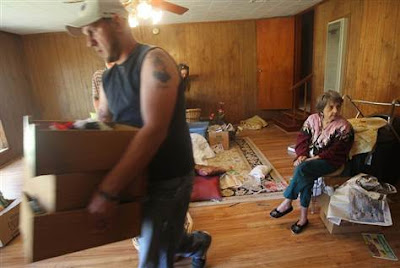Floodwater creeps closer to La. towns
Deputies warned people Sunday to get out as water gushing from a floodgate for the first time in four decades crept ever closer to communities in the Louisiana Cajun country, slowly filling a river basin like a giant bathtub.
Most residents heeded the warnings and headed for higher ground, even in places where there hasn't been so much as a trickle, hopeful that the flooding engineered to protect New Orleans and Baton Rouge would be merciful to their way of life.
Days ago, many of the towns known for their Cajun culture and drawling dialect fluttered with activity as people filled sandbags and cleared out belongings. By Sunday, some areas were virtually empty as the water from the Mississippi River, swollen by snowmelt and heavy rains, slowly rolled across the Atchafalaya River basin. The floodwaters could reach depths of 20 feet in the coming weeks.
The spillway's opening diverted water from heavily populated New Orleans and Baton Rouge — along with chemical plants and oil refineries along the Mississippi's lower reaches — easing pressure on the levees there in the hope of avoiding potentially catastrophic floods.
About 11 miles north of Krotz Springs in the town of Melville, water was already starting to creep into some people's backyards. Parts of the town not protected by levees were under a mandatory evacuation order. Glenda Maddox's husband had temporarily reopened the gas station he closed in December so people could fuel up before they leave.
"Nobody knows what's going to happen," she said. "We don't know if the levee is going to hold up."
The station's shelves were mostly barren, save for a few soft drinks and bottles of motor oil. Only cash was accepted— no credit cards.
In Butte LaRose, some 50 miles downstream from where the Morganza spillway was opened, no water was expected until at least later Sunday. But Chalmers Wheat, 54, was among the few left — and even he was headed for his father's home in Baton Rouge outside the flood zone. He and his brother were making a few final preparations to protect his home with plastic lining and sandbags.
"It's almost like a ghost town," said Wheat, who was getting some help from his twin brother, Chandler.
Sandbags were still available in the center of town, but there were few takers Sunday.
Krotz Springs is roughly 30 miles closer to the floodgates, and deputies ordered people to evacuate Sunday morning even though the water hadn't yet arrived.
Story: Century of disasters — how you can cope
Wayne Duplechain, who lives in the parish about eight miles outside Krotz Springs, said he would have his family stay in a camper parked on his son's property outside the flood zone. He hoped to return, though, and ride out the flooding. He has three layers of sandbags stacked 2 feet high surrounding his ranch-style, brick house and figures the water won't start lapping against them for seven or eight days. Plus, he has a generator and a boat to escape in if the water gets too high.
"It's going to be slow-rising, so I'll get out if I have to. I'm not totally stupid," he said. "If it comes over the sandbags, I'm leaving."
It will be at least a week before the Mississippi River crest arrives at the Morganza spillway, where officials opened two massive gates on Saturday and another two Sunday. There are 125 in all. The Mississippi has broken river-level records that had held since the 1920s in some places.
The Army Corps of Engineers has taken drastic steps to prevent flooding. Engineers blew up a levee in Missouri — inundating an estimated 200 square miles of farmland and damaging or destroying about 100 homes — to take the pressure off floodwalls protecting the town of Cairo, Ill., population 2,800.
The Morganza flooding is more controlled, however, and residents are warned each year that the spillway could be opened. A spillway at the 7,000-foot Bonnet Carre structure in Louisiana also has been opened.
Just outside Krotz Springs, 23-year-old Jake Nolan said National Guard troops knocked on the door of his home in a subdivision to tell his mother of the evacuation order. He said they advised her to have white towels and have access to the roof if they planned to ride it out — presumably in case of a rescue — though that didn't appear to be part of any official instructions. And besides, he didn't need an order to leave with his wife and three children.
"I don't want to be stuck here if the water does get bad," said Nolan, who planned to stay with a sister in Port Barre.
It seemed animals didn't want to be stuck anywhere, either: Deer, hogs and rabbits have started running from the water flowing near the floodgates, said Lt. Col. Joey Broussard of the Louisiana Department of Wildlife and Fisheries. An electronic sign on Interstate 10 warned of a possible animal exodus: "Wildlife crossing possible. Use caution," it read.
Despite the mandatory evacuation order for some people, Krotz Springs town clerk Suzanne Bellau said it was unlikely the sheriff's office would force people to leave. For most, the worst part was wondering what may happen. National Guardsman were building a new levee to bolster protection for the town, in addition to a levee already standing.
"It's the unknown, that's the problem," Bellau said. "Is it going to come into their homes or not? And the people who are leaving, what are they coming back to?"
That was also true downstream in Butte LaRose, where Chalmers and Chandler Wheat had been making last-minute preparations. Chalmers Wheat figured his house would be all right so long as the water level didn't exceed 2 feet.
"If the water gets higher, we're pretty much ..." Chalmers Wheat said, before his brother chimed in: "Screwed."
Source: msnbc.msn.com
